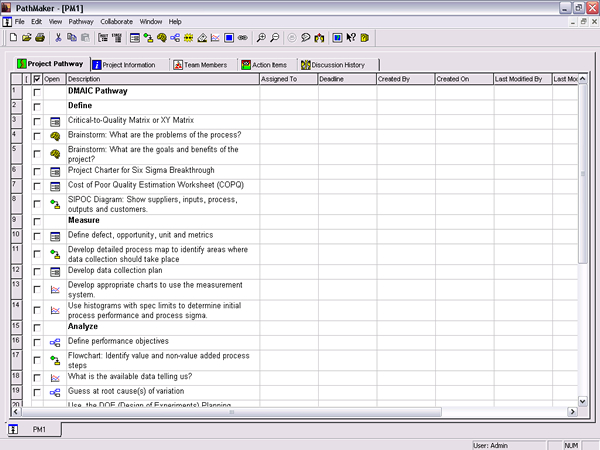
PathMaker is the Most Complete Six Sigma Quality Software Solution
Six Sigma Quality is… what? It's a very specific measure, and it's a new way of managing. PathMaker helps you translate it from a new idea, to an actual working system, in your organization, without a huge investment.
Six Sigma gets its name from a fairly arcane statistical measure -- how wide a process is vs. its specification limits. The point is that making parts that are out of spec is expensive for everyone, so we want to reduce variation until the actual variation in the process is much less than the variation that is allowed by the specification. Then… defects are very rare, and the costs of production and use are reduced all along the line from the originator of the process to the end user.
Six Sigma Quality also emphasizes the importance of having trained experts - Six Sigma Black Belts - who are itinerant problem-solvers and process-improvers. There has always been a tension between having the expert - it used to be the industrial engineer - come in and solve a problem, and the quality circle or team idea - in which every member has expertise that is needed. There's no reason not to have both. It's silly to ignore the expertise that exists in the people who work in the process every day. It's also silly to think that expert problem-solving skills can't or won't be valuable. The pendulum swings back and forth; with Six Sigma, it has swung back towards the expert, but not to the exclusion of the team.
The tools used in Six Sigma Quality are familiar. For data collection and analysis, you need modern spreadsheet software with appropriate charts - especially control charts, Pareto's and histograms. For thinking of creative solutions to problems, there's brainstorming and affinity diagramming. For decision-making, you need structured discussion, multivoting, and weighted rating tools. If you are working as a team, it helps to have team support tools, such as central document storage, a project pathway, and computer-based agendas and minutes.

SkyMark's PathMaker software is a great tool for guiding a Six Sigma project, because it has all these tools. A pathway template for systematic process improvement is provided. Like all PathMaker templates, you can use it as is, change it, or make your own. PathMaker also includes extensive training materials - slideshows, on-line context-sensitive help, and help cards - which are great refreshers for Black Belts, and good introductions for Green Belts. With PathMaker, you can get into Six Sigma Quality quickly, and start getting high returns with your very first projects.
People frequently ask us about how PathMaker relates to Minitab, the excellent statistical software made on the other side of the Alleghenies in State College, PA. Here's what we tell them:
"Minitab is a very good statistical tool, and it has gained wide acceptance as a Six Sigma Quality tool. We see it as a very good complement to PathMaker. PathMaker has the project tools, meeting tools, creativity tools, flowcharting, root cause analysis and many others. Where our Data Analyst tool leaves off, Minitab can take over, to do the high-end stats, the regression analysis, or the design of experiments work. PathMaker is probably all that a Green Belt will ever need; a Black Belt will want both packages."

